 Flying into the little airport just outside Corfu Town is one of those fairly spectacular descents that adds just a tinge of uncertainty to the fabulous views – we banked over the mountain tops behind the little resort of Benitses (where we would be staying) and skimmed over the causeway crossing the bay before the steep descent onto the tiny runway, which ends metres from one of the main roads out of the town.
Flying into the little airport just outside Corfu Town is one of those fairly spectacular descents that adds just a tinge of uncertainty to the fabulous views – we banked over the mountain tops behind the little resort of Benitses (where we would be staying) and skimmed over the causeway crossing the bay before the steep descent onto the tiny runway, which ends metres from one of the main roads out of the town.
My sister, Julia, met us from the airport with her daughters, Lettie and Ellie (11 and 8 at the time), and whisked us away to a café for a much needed cold drink, then on into Corfu Town to the huge, green Plateia Leonida Vlachou, a kind of park-cum-town square. It was late April; the sun was streaming down, and we stood among the few trees, with the breeze drifting in from the nearby sea making the leaves dance above our heads. 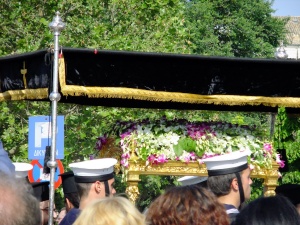 Earlier in the day, which was Palm Sunday, the relics of St Spyridon had been paraded through the nearby streets and the accompanying processions were still going on, with each local church represented by priests, nuns and local authority representatives carrying relics and icons, and brass bands (the Philharmonics, as they are known) following on. We relaxed there for a while, listening to the sounds and watching the different processions, before Julia drove us to our hotel in Benitses, about 8km from Corfu Town, so that we could check in.
Earlier in the day, which was Palm Sunday, the relics of St Spyridon had been paraded through the nearby streets and the accompanying processions were still going on, with each local church represented by priests, nuns and local authority representatives carrying relics and icons, and brass bands (the Philharmonics, as they are known) following on. We relaxed there for a while, listening to the sounds and watching the different processions, before Julia drove us to our hotel in Benitses, about 8km from Corfu Town, so that we could check in.
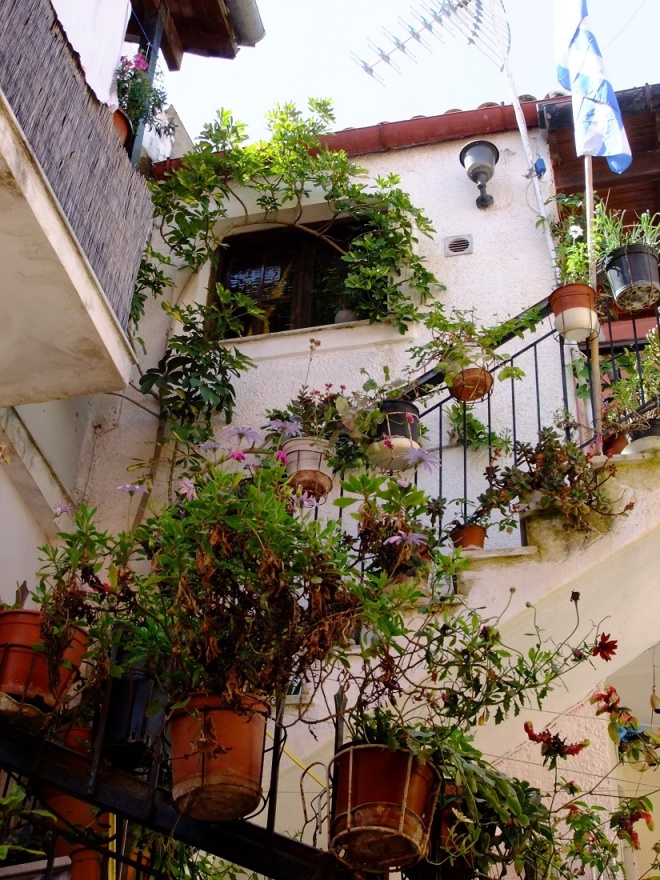 At this time of year, Corfu is absolutely beautiful. The weather is hot, but there is still a freshness to the breeze, when it comes. Everything is green, with flowers
At this time of year, Corfu is absolutely beautiful. The weather is hot, but there is still a freshness to the breeze, when it comes. Everything is green, with flowers  blooming everywhere, and the beaches are not yet full of tourists. We spent our first day in and around Benitses itself, buying bottled water, juice and breakfast brioches from the tiny local supermarket, walking around the little marina and watching the yachts bobbing up and down serenely in the rippling water, eating ice creams and following a path up into the mountain behind the town. From up there we could look down over the coastline, so serene and peaceful.
blooming everywhere, and the beaches are not yet full of tourists. We spent our first day in and around Benitses itself, buying bottled water, juice and breakfast brioches from the tiny local supermarket, walking around the little marina and watching the yachts bobbing up and down serenely in the rippling water, eating ice creams and following a path up into the mountain behind the town. From up there we could look down over the coastline, so serene and peaceful.
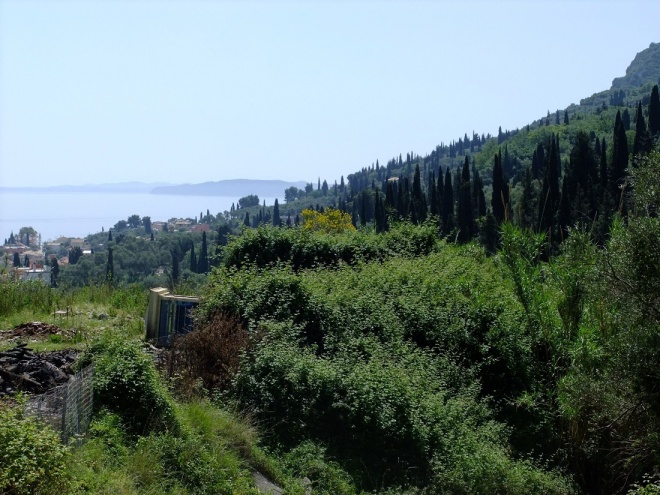 We knew the week ahead was going to be busy. We wanted to spend some time with Julia and her family (she’s lived on Corfu for many years now, with a Greek husband and their two beautiful bi-lingual daughters); but we also wanted to spend a bit of time exploring on our own, and to find out what Easter was like on the island. We already knew quite a bit: the whole week leading up to Easter Sunday in Corfu is based around preparations for what is, as in many Mediterranean countries, the most important religious festival of the year, and the associated traditions and religious (and non-religious) activities are taken very seriously. While most of us in the UK will be stockpiling hot cross buns and overpriced, over-packaged chocolate (mostly egg-shaped, but I swear I saw a chocolate Easter dinosaur the other day!), the Corfiot population will be buying ingredients to cook traditional local dishes, decorating candles and attending special concerts, poetry recitals and church services.
We knew the week ahead was going to be busy. We wanted to spend some time with Julia and her family (she’s lived on Corfu for many years now, with a Greek husband and their two beautiful bi-lingual daughters); but we also wanted to spend a bit of time exploring on our own, and to find out what Easter was like on the island. We already knew quite a bit: the whole week leading up to Easter Sunday in Corfu is based around preparations for what is, as in many Mediterranean countries, the most important religious festival of the year, and the associated traditions and religious (and non-religious) activities are taken very seriously. While most of us in the UK will be stockpiling hot cross buns and overpriced, over-packaged chocolate (mostly egg-shaped, but I swear I saw a chocolate Easter dinosaur the other day!), the Corfiot population will be buying ingredients to cook traditional local dishes, decorating candles and attending special concerts, poetry recitals and church services.  In the Liston, a park opposite a beautiful, long colonnaded building in the town, local bands will practise parading up and down, and special brioche-type Easter loaves (fogatses) and almond and honey flavoured macaroons (mandolato) will start appearing in the windows of bakers’ shops. Lettie and Ellie had been busy decorating candles for Colin and I – mine had a picture of Tinkerbell on it! – and later in the week (Maundy Thursday, traditionally) they would be dying eggs red. These red eggs are used to decorate the fogatses, and children also like to bang their red eggs together to see whose egg holds out for longest before the shell breaks.
In the Liston, a park opposite a beautiful, long colonnaded building in the town, local bands will practise parading up and down, and special brioche-type Easter loaves (fogatses) and almond and honey flavoured macaroons (mandolato) will start appearing in the windows of bakers’ shops. Lettie and Ellie had been busy decorating candles for Colin and I – mine had a picture of Tinkerbell on it! – and later in the week (Maundy Thursday, traditionally) they would be dying eggs red. These red eggs are used to decorate the fogatses, and children also like to bang their red eggs together to see whose egg holds out for longest before the shell breaks.
 Easter celebrations really escalate on Good Friday. Each church decorates a symbolic funeral bier (epitafios) with flowers and embroidered images of Christ. Following the ceremony, each of the epitafios is taken out of the church, followed by the priest, the congregation and a brass band. In Corfu Town alone there are more than 25 epitafios processions and they all converge in the centre of the town, with the procession from the Orthodox Cathedral at 10pm being the final and most important and impressive of all. By this time, darkness has fallen;
Easter celebrations really escalate on Good Friday. Each church decorates a symbolic funeral bier (epitafios) with flowers and embroidered images of Christ. Following the ceremony, each of the epitafios is taken out of the church, followed by the priest, the congregation and a brass band. In Corfu Town alone there are more than 25 epitafios processions and they all converge in the centre of the town, with the procession from the Orthodox Cathedral at 10pm being the final and most important and impressive of all. By this time, darkness has fallen; 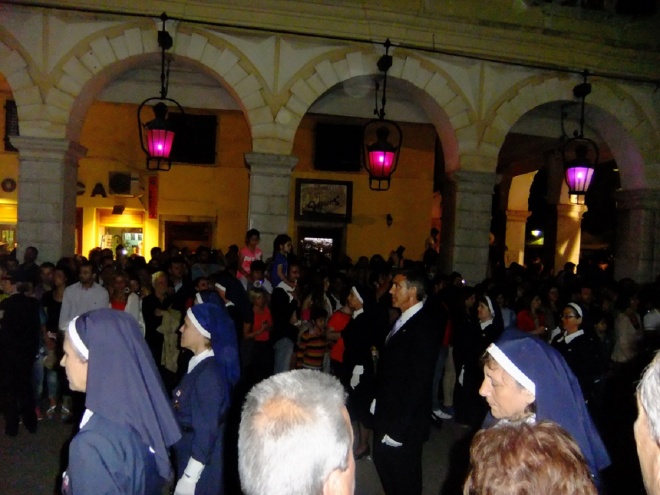 the Venetian lights all the way along the Liston are coloured purple as a sign of mourning, and the local Philharmonics each traditionally play specific funereal music.
the Venetian lights all the way along the Liston are coloured purple as a sign of mourning, and the local Philharmonics each traditionally play specific funereal music.
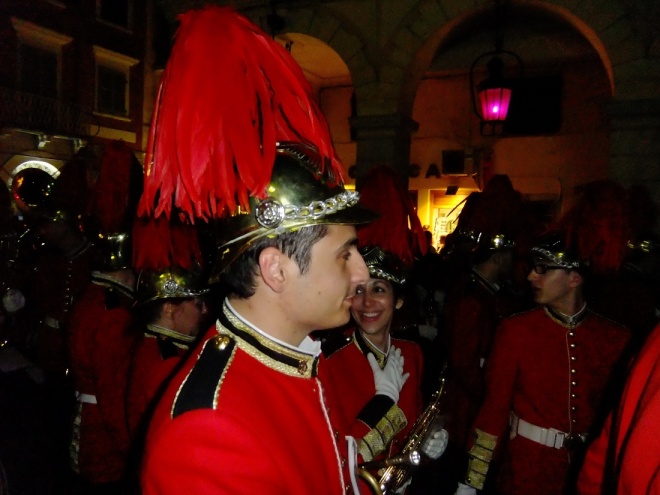
The atmosphere now is something very special. The balconies of the surrounding hotels and apartments are full of people,  leaning out to get a better view of the spectacle marching slowly along the street. A TV camera is held high by a small crane, sending live images to people in little remote villages all over the island. Every outside table of every bar and restaurant has been taken, people having staked their places hours before. The streets are packed, and we are hemmed in by bodies in every direction.
leaning out to get a better view of the spectacle marching slowly along the street. A TV camera is held high by a small crane, sending live images to people in little remote villages all over the island. Every outside table of every bar and restaurant has been taken, people having staked their places hours before. The streets are packed, and we are hemmed in by bodies in every direction. 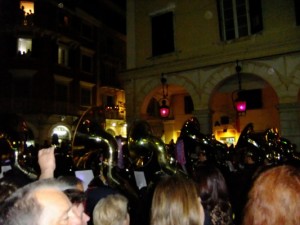 Small children have been lifted onto Daddy’s shoulders, and camera flashes blink constantly. The polished brass of the bands’ instruments reflects the lights all around, as they play the deep, sombre notes of Abinoni’s “Adagio” or Mariani’s “Sventuro”. You feel as well as hear the slow, heavy drumbeats, and as the procession passes by, lit by hundreds of raised, flickering candles, there is a sense of something shared; something important and moving.
Small children have been lifted onto Daddy’s shoulders, and camera flashes blink constantly. The polished brass of the bands’ instruments reflects the lights all around, as they play the deep, sombre notes of Abinoni’s “Adagio” or Mariani’s “Sventuro”. You feel as well as hear the slow, heavy drumbeats, and as the procession passes by, lit by hundreds of raised, flickering candles, there is a sense of something shared; something important and moving.
 The music and the drumbeat eventually dies away, and the chatter among the crowd starts up again, having quelled during the final procession. The crowd disperses – parents take young children home to bed, couples wander off to bars and we head off for the last bus back to Benitses. It’s very tempting to stay longer, to breathe in a little more of the atmosphere of this special, balmy night, but we have to be up early in the morning.
The music and the drumbeat eventually dies away, and the chatter among the crowd starts up again, having quelled during the final procession. The crowd disperses – parents take young children home to bed, couples wander off to bars and we head off for the last bus back to Benitses. It’s very tempting to stay longer, to breathe in a little more of the atmosphere of this special, balmy night, but we have to be up early in the morning.

 A quick breakfast of brioche, coffee and orange juice on our terrace looking out over the rooftops of Benitses to the sea beyond, and then it’s off to the bus for the 20 minute ride back into Corfu Town.
A quick breakfast of brioche, coffee and orange juice on our terrace looking out over the rooftops of Benitses to the sea beyond, and then it’s off to the bus for the 20 minute ride back into Corfu Town.  We’re meeting Julia, Lettie and Ellie to witness something unique and very special, something which only takes place in Corfu, and only on Easter Saturday. We’ve arrived early, so we lose ourselves in the little back streets, following the distant sound of music to a little square where a band is playing something beautiful, atmospheric and intensely moving. It’s one of those perfect moments, when you know you’re in exactly the right place at the right time, and we share this moment with people of all ages, entranced by the music.
We’re meeting Julia, Lettie and Ellie to witness something unique and very special, something which only takes place in Corfu, and only on Easter Saturday. We’ve arrived early, so we lose ourselves in the little back streets, following the distant sound of music to a little square where a band is playing something beautiful, atmospheric and intensely moving. It’s one of those perfect moments, when you know you’re in exactly the right place at the right time, and we share this moment with people of all ages, entranced by the music.

 We meet Julia and the girls back at the Plateia, where crowds have already gathered; many people are carrying little clay pots, which we’d noticed for sale all over the city in the preceding days. We push through the crowds to a spot at the southern end of the Liston, close to several apartment buildings.
We meet Julia and the girls back at the Plateia, where crowds have already gathered; many people are carrying little clay pots, which we’d noticed for sale all over the city in the preceding days. We push through the crowds to a spot at the southern end of the Liston, close to several apartment buildings.  Once again, the balconies are packed solid, many of them with red cloths draped over them. At 6 o’clock that morning, we could have gone to the church of Panogio ton Xenon (the Madonna of Foreigners) to see a re-creation of the earthquake which, according to Orthodox scriptures, took place at the moment of Christ’s resurrection. At 9am, another procession had wound it’s way through the streets, with it’s epitafios, it’s funereal music and it’s relics, which we’d also missed.
Once again, the balconies are packed solid, many of them with red cloths draped over them. At 6 o’clock that morning, we could have gone to the church of Panogio ton Xenon (the Madonna of Foreigners) to see a re-creation of the earthquake which, according to Orthodox scriptures, took place at the moment of Christ’s resurrection. At 9am, another procession had wound it’s way through the streets, with it’s epitafios, it’s funereal music and it’s relics, which we’d also missed.

 At 11 am on the dot, the mood changes. Up on the balconies and window ledges, clay pots of all shapes and sizes are appearing. You can feel the excitement and anticipation spreading through the crowd like a breeze; cameras and phones are
At 11 am on the dot, the mood changes. Up on the balconies and window ledges, clay pots of all shapes and sizes are appearing. You can feel the excitement and anticipation spreading through the crowd like a breeze; cameras and phones are  held high, and fingers point towards a large pot, the size of a head, as it’s pushed over the balcony to the street below (the area beneath the buildings has been cleared of people, obviously). Gradually, as we watch, we see pots falling all over the place – we’re speechless at the craziness of it, our eyes darting backwards and forwards as we try to catch sight of the biggest ones just at the point of no return. After a few minutes, a particularly tall pot is hoisted onto the railings of a balcony. It must be about 70cms tall, and pretty heavy.
held high, and fingers point towards a large pot, the size of a head, as it’s pushed over the balcony to the street below (the area beneath the buildings has been cleared of people, obviously). Gradually, as we watch, we see pots falling all over the place – we’re speechless at the craziness of it, our eyes darting backwards and forwards as we try to catch sight of the biggest ones just at the point of no return. After a few minutes, a particularly tall pot is hoisted onto the railings of a balcony. It must be about 70cms tall, and pretty heavy.  You can almost imagine it’s owner making a speech, in his head, to the crowd: “Hey, look everybody, look at my pot! Is it not bigger and heavier than all the other pots? Look how tall, how beautiful it is! Watch me as I send my tall, heavy, beautiful pot crashing to the ground and marvel as it explodes into a million pieces…..!!” The crowd has noticed the pot, and the crowd is impressed. People nudge each other and point, cameras are poised and a murmur of appreciation ripples through us all like a wave. It is, indeed, a Very Fine Pot. The Pot Man knows that this is his moment; and with a gentle flick of the wrist, he pushes the pot over the edge and it smashes on the ground, out of sight.
You can almost imagine it’s owner making a speech, in his head, to the crowd: “Hey, look everybody, look at my pot! Is it not bigger and heavier than all the other pots? Look how tall, how beautiful it is! Watch me as I send my tall, heavy, beautiful pot crashing to the ground and marvel as it explodes into a million pieces…..!!” The crowd has noticed the pot, and the crowd is impressed. People nudge each other and point, cameras are poised and a murmur of appreciation ripples through us all like a wave. It is, indeed, a Very Fine Pot. The Pot Man knows that this is his moment; and with a gentle flick of the wrist, he pushes the pot over the edge and it smashes on the ground, out of sight.  I expect a round of applause, but the crowd is already looking for something bigger and better. More pots, some full of water, tumble down, and we try (mostly unsuccessfully) to capture the moment on our cameras.
I expect a round of applause, but the crowd is already looking for something bigger and better. More pots, some full of water, tumble down, and we try (mostly unsuccessfully) to capture the moment on our cameras.
 Suddenly our eyes are drawn upwards. On the top floor of one of the buildings a massive red pot has appeared, bigger than any we’d seen before. It’s huge. I imagine the previous Big Pot Man seething with jealousy, but I can’t take my eyes off this new pot, the size of a pig, teetering on its ledge high above the watching crowd. It’s owner (who even from this distance I can tell has a smug expression on his face) tilts the pot… ever so slightly…over the edge before easing it back again. “Ooooh!!…”, says the crowd. Cameras once again are held high, and sensing his inner Showman, the Bigger Pot Man nudges it forward again. “Aaaah!!!…” says the crowd, willing the giant red pot to fall……and then down it goes, manhandled over the balcony by a man who will be the toast of the local bars for weeks to come, and it crashes and explodes noisily on the pavement below.
Suddenly our eyes are drawn upwards. On the top floor of one of the buildings a massive red pot has appeared, bigger than any we’d seen before. It’s huge. I imagine the previous Big Pot Man seething with jealousy, but I can’t take my eyes off this new pot, the size of a pig, teetering on its ledge high above the watching crowd. It’s owner (who even from this distance I can tell has a smug expression on his face) tilts the pot… ever so slightly…over the edge before easing it back again. “Ooooh!!…”, says the crowd. Cameras once again are held high, and sensing his inner Showman, the Bigger Pot Man nudges it forward again. “Aaaah!!!…” says the crowd, willing the giant red pot to fall……and then down it goes, manhandled over the balcony by a man who will be the toast of the local bars for weeks to come, and it crashes and explodes noisily on the pavement below.
 We watch and wait; a few more pots are thrown, but nothing else quite so spectacular. The show is over, for this year. The crowd has been entertained, and the officials allow people back into the area below the buildings.
We watch and wait; a few more pots are thrown, but nothing else quite so spectacular. The show is over, for this year. The crowd has been entertained, and the officials allow people back into the area below the buildings.  Children scamper forward to collect pieces of broken pottery for luck and everyone ambles off, disappearing slowly into the maze of little streets to find an ice-cold frappe and something to nibble. After a brief lunch, Julia heads off home with the girls (she has food to prepare ready for tomorrow), while Colin and I walk along the seafront, watching the cruise ships gliding towards the harbour, and drinking in the sunshine and the happy chatter all around us, before taking the bus back to Benitses.
Children scamper forward to collect pieces of broken pottery for luck and everyone ambles off, disappearing slowly into the maze of little streets to find an ice-cold frappe and something to nibble. After a brief lunch, Julia heads off home with the girls (she has food to prepare ready for tomorrow), while Colin and I walk along the seafront, watching the cruise ships gliding towards the harbour, and drinking in the sunshine and the happy chatter all around us, before taking the bus back to Benitses.

 As the bus stops, back at Benitses, we see that a small stage area is being erected in the centre of the village; there is a sense of hustle and bustle as we make
As the bus stops, back at Benitses, we see that a small stage area is being erected in the centre of the village; there is a sense of hustle and bustle as we make  our way back up the steep little lane to our home for the week, the lovely Argo Studios, where the owners, Anna and Spiros, are keen to hear what we thought of the festivities in the Town. They have kindly left a couple of candles by our bedside (but, of course, we’re going to use the ones the girls made for us). Spiros invites us to join him later that night for a bowl of Magiritsa – a traditional Greek Easter soup, made with lamb offal and lettuce, and usually eaten just after midnight. I decline as politely as I can (even the smell of offal turns my stomach!), but Colin is polite and agrees that he’d love to try a little, later on. But for now we have to get ready; as the sun starts to set, people in little towns and villages all over the island are preparing for candle-lit processions to local churches.
our way back up the steep little lane to our home for the week, the lovely Argo Studios, where the owners, Anna and Spiros, are keen to hear what we thought of the festivities in the Town. They have kindly left a couple of candles by our bedside (but, of course, we’re going to use the ones the girls made for us). Spiros invites us to join him later that night for a bowl of Magiritsa – a traditional Greek Easter soup, made with lamb offal and lettuce, and usually eaten just after midnight. I decline as politely as I can (even the smell of offal turns my stomach!), but Colin is polite and agrees that he’d love to try a little, later on. But for now we have to get ready; as the sun starts to set, people in little towns and villages all over the island are preparing for candle-lit processions to local churches.  Colin and I light the candles that my nieces had so beautifully decorated, and follow family groups and friends up the steep road and steps to the pretty little church; in the twilight, the flickering flames light up happy faces, and while a few of the older people seem more serious, more thoughtful, the general feeling is of contentment, of love and companionship, and of tradition. While many of the people eventually wander into the church, we hover for a while before
Colin and I light the candles that my nieces had so beautifully decorated, and follow family groups and friends up the steep road and steps to the pretty little church; in the twilight, the flickering flames light up happy faces, and while a few of the older people seem more serious, more thoughtful, the general feeling is of contentment, of love and companionship, and of tradition. While many of the people eventually wander into the church, we hover for a while before  picking our way down the steps and along the sloping lane back to the village centre. People are ambling around with bottles of beer, children are chasing each other through the trees, toddlers in pushchairs are eating huge, messy ice creams and all the tables under the awnings of the sea-facing restaurants are full of noisy diners. Amazingly, one of Julia’s friends (who I’ve never met before) recognises me among the crowd from Julia’s photos – there’s obviously quite a family resemblance – and we have a brief chat with her and her husband. They seem like lovely people, but they are out to meet up with friends and family (like Julia, they’ve lived on Corfu for many years), so we leave them to enjoy the festivities.
picking our way down the steps and along the sloping lane back to the village centre. People are ambling around with bottles of beer, children are chasing each other through the trees, toddlers in pushchairs are eating huge, messy ice creams and all the tables under the awnings of the sea-facing restaurants are full of noisy diners. Amazingly, one of Julia’s friends (who I’ve never met before) recognises me among the crowd from Julia’s photos – there’s obviously quite a family resemblance – and we have a brief chat with her and her husband. They seem like lovely people, but they are out to meet up with friends and family (like Julia, they’ve lived on Corfu for many years), so we leave them to enjoy the festivities. Colin and I walk to the front of the harbour; at the stroke of midnight, Corfu Town has a massive firework display, which we’ve been told may be visible from Benitses, all the way around the bay. But apart from a faint glow in the sky in that direction, there’s nothing to see; there are no bangs and whizzes to be heard either – just the sound of water lapping against the low marina walls, the occasional creak and knock of little wooden boats gently bumping together,
Colin and I walk to the front of the harbour; at the stroke of midnight, Corfu Town has a massive firework display, which we’ve been told may be visible from Benitses, all the way around the bay. But apart from a faint glow in the sky in that direction, there’s nothing to see; there are no bangs and whizzes to be heard either – just the sound of water lapping against the low marina walls, the occasional creak and knock of little wooden boats gently bumping together,  and the muffled sounds of music and laughter from the village square. We go for a walk to the far end of the village, in the opposite direction from Corfu Town, where the village noise is replaced by chirruping crickets and the occasional barking dog. Nobody seems to be at home; the few houses we pass are in darkness – everyone is in the village, so we turn round and eventually head back to the hotel. Spiros welcomes us back and insists that we sit down at one of the little tables by the pool so that Colin can try the Magiritsa. I choose a cocktail instead, which slides down very nicely, as I watch Colin bravely chewing unrecognisable pieces of sheep’s innards floating in the strong-tasting soup. Spiros offers him more, but he politely declines. I make a mental note to order him to brush his teeth very thoroughly when we get back to our room.
and the muffled sounds of music and laughter from the village square. We go for a walk to the far end of the village, in the opposite direction from Corfu Town, where the village noise is replaced by chirruping crickets and the occasional barking dog. Nobody seems to be at home; the few houses we pass are in darkness – everyone is in the village, so we turn round and eventually head back to the hotel. Spiros welcomes us back and insists that we sit down at one of the little tables by the pool so that Colin can try the Magiritsa. I choose a cocktail instead, which slides down very nicely, as I watch Colin bravely chewing unrecognisable pieces of sheep’s innards floating in the strong-tasting soup. Spiros offers him more, but he politely declines. I make a mental note to order him to brush his teeth very thoroughly when we get back to our room.
 Easter Day; Sunday. After another breakfast on our terrace overlooking the pool, we get the bus the few kilometres along the coast to Julia’s house, where we have been invited to her (extended) family’s Easter lunch at the home of her In-Laws next door; there are aunts and uncles, cousins, nieces and nephews, and we are introduced to everybody. They are all incredibly welcoming, doing their best to include us in their conversations (we don’t speak Greek, so a lot of the ‘conversation’ involved piling heaps of delicious food on our plates and smiling a lot)! Huge mounds of food have been laid out on a big table on their terrace; we eat roasted goat, salad, spanakopita (spinach in flaky filo pastry), bread and roasted potatoes, while the children race around, returning every few minutes to graze on a little more food before shooting off to play outside again in the hot sun. It’s all delicious, and there’s probably enough here to feed the whole village for a week – I know that, over the last few days, Julia has been cooking bits and pieces to contribute to the feast, as have all the other women in the family. The meal lasts most of the afternoon, and I know that all around the little village – in fact, all over the island – thousands of people are doing exactly the same: sharing good, home-cooked food with their families, enjoying the sunshine, the company, and the sense of tradition. Colin and I feel very honoured to have been invited to share this special occasion with such lovely people.
Easter Day; Sunday. After another breakfast on our terrace overlooking the pool, we get the bus the few kilometres along the coast to Julia’s house, where we have been invited to her (extended) family’s Easter lunch at the home of her In-Laws next door; there are aunts and uncles, cousins, nieces and nephews, and we are introduced to everybody. They are all incredibly welcoming, doing their best to include us in their conversations (we don’t speak Greek, so a lot of the ‘conversation’ involved piling heaps of delicious food on our plates and smiling a lot)! Huge mounds of food have been laid out on a big table on their terrace; we eat roasted goat, salad, spanakopita (spinach in flaky filo pastry), bread and roasted potatoes, while the children race around, returning every few minutes to graze on a little more food before shooting off to play outside again in the hot sun. It’s all delicious, and there’s probably enough here to feed the whole village for a week – I know that, over the last few days, Julia has been cooking bits and pieces to contribute to the feast, as have all the other women in the family. The meal lasts most of the afternoon, and I know that all around the little village – in fact, all over the island – thousands of people are doing exactly the same: sharing good, home-cooked food with their families, enjoying the sunshine, the company, and the sense of tradition. Colin and I feel very honoured to have been invited to share this special occasion with such lovely people.

 A couple of days later, we return to the UK. Easter, in all its commercial glory, had been done and dusted; everyone is sick of hot cross buns and Cadbury’s Creme Eggs. To the majority of Britons, Easter has simply been an excuse to eat too much and have a couple of extra days off work. Easter in Britain has become very superficial, very commercialised. Easter in Corfu, on the other hand, has been an experience that will stay with me for a long, long time. It is a celebration of religion, of tradition; of family and of community. I’m not a religious person, but there was definitely something special and spiritual in the Greek celebrations which is sadly lacking in Britain; and I think we, as a nation, are seriously missing out…
A couple of days later, we return to the UK. Easter, in all its commercial glory, had been done and dusted; everyone is sick of hot cross buns and Cadbury’s Creme Eggs. To the majority of Britons, Easter has simply been an excuse to eat too much and have a couple of extra days off work. Easter in Britain has become very superficial, very commercialised. Easter in Corfu, on the other hand, has been an experience that will stay with me for a long, long time. It is a celebration of religion, of tradition; of family and of community. I’m not a religious person, but there was definitely something special and spiritual in the Greek celebrations which is sadly lacking in Britain; and I think we, as a nation, are seriously missing out…
Info: We stayed at the lovely Argo Studios and Apartments, Benitses 49084, Corfu, Greece. http://www.argobenitses.gr
Very interesting Paula. Brought it all back to me. It’s a few years since I was there for Easter and it certainly was something special . Thanks.
LikeLike
I’m glad you enjoyed the post!
LikeLike
Such a lovely story I am reading with a big smile and can imagine how wonderful, so look forward to the next station you are going and sharing your lovely story and of course those photos. Thank you very much. Usanee 😊❤️🙏 Xxxx
LikeLike
Thank you, Usanee, and thank you for following my blog! xx
LikeLike
Interesting! I like to read posts from other people who have enjoyed Corfu. We are currently moored in the harbour at Benitses on our yacht, we spend six months in the summer sailing round the greek islands. I have written several posts about Benitses.. We have been here many times, it’s sad to see all the disused and abandoned clubs and bars along the Main Street, it must have been so different In the 1970s and 80s when Benitses had its heyday and was a Mecca for kids wanting a good time. I think there are many more authentic greek places with better beaches, but Benitses does have a charm of its own, especially the old village with its narrow streets, churches etc, and we always enjoy walking into the hills up to the springs behind the town.
LikeLike
I agree; we loved climbing up into the hills….hearing the frogs croaking, butterflies everywhere, water trickling from the springs….and what a lovely view down to the bay! We loved it there, and it definitely has a charm of its own.
LikeLike